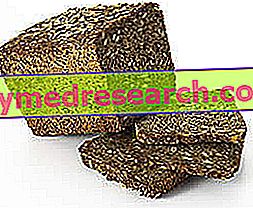Rye
Rye is a herbaceous plant native to Asia Minor, belonging to the Poaceae family (Gramineae).
As its binomial nomenclature ( Secale cereale ) reminds, rye belongs to the group of cereals and very much resembles the much more well-known grain or wheat; not surprisingly, rye contains gluten and, despite being less valuable, provides a flour suitable for bread-making. On the other hand, rye is NOT suitable for celiacs (it is not gluten-free).

There are two main varieties of rye, winter and summer; in both cases, its cultivation is decidedly less problematic than that of wheat. In fact, the plant better resists cold, ventilated and dry climates; moreover, it does not require particularly fertile soils. Currently, most of the world rye production comes from central Europe and, in Italy, its cultivation is concentrated in the north, in the high hill and mountain areas.
In Russia, the spread of rye bread greatly exceeds that of wheat analogue. The plant has also been used to obtain a hybrid with wheat; this cross is called Triticale .
Rye Bread and Yogurt - Soft Bread with Poppy Seeds and Sesame Seeds
X Problems with video playback? Reload from YouTube Go to Video Page Go to Video Recipes Section Watch the video on youtubeRye flour
Rye flour is produced by grinding the seeds of Secale cereale ; there are various types: light, intermediate, dark, integral and partially integral. Its peculiarity is that of having a low bread-making power compared to wheat; this is due to the fact that the POCO gluten contained in it (gliadin + glutenin), while activating in the presence of water, interacts negatively with the numerous pentosans . These molecules are polysaccharides composed of pentose monosaccharides (xylans) which man is unable to digest; in summary, rye pentosans are one of the light fibrous portions of the soluble, or rather viscous, type.
| Composition for: 100g of Rye flour | ||||||||||||||||||||||||||||||||||||||||||||||||||||||||||||||||||||||||||||||||||||||||||||||||||||||||||||||||||||||||||||||||||||||||||||
 | ||||||||||||||||||||||||||||||||||||||||||||||||||||||||||||||||||||||||||||||||||||||||||||||||||||||||||||||||||||||||||||||||||||||||||||
Nutritional values (per 100 g of edible portion)
| ||||||||||||||||||||||||||||||||||||||||||||||||||||||||||||||||||||||||||||||||||||||||||||||||||||||||||||||||||||||||||||||||||||||||||||
While rye flour is rich in soluble fiber, with all the advantages that can be derived from it in healthy terms (greater satiety, modulation of absorption and glycemic index, prebiotic effect, antitumor for the intestine, etc.). ), on the other hand it tends to absorb large amounts of water (osmotic effect of pentosans and starch, which gelatinize more quickly and to a greater extent); this prevents the correct swelling of the glutinous network, hindering the bread making process.
On the other hand, this flour contains higher percentages of lytic enzymes than proteins and starch, therefore also maltodextrins and oligosaccharides, which contribute to increasing the power of pasta to retain water.
To obtain an "acceptable" rye bread (with respect to the taste of the community, accustomed to that of wheat) it is fundamental to take care of the dough stage. Unlike that of wheat, the rye flour compound is more similar to a solution of water and water-soluble components, in which more solid particles are suspended; the consistency of the dough is not very elastic and almost completely devoid of resistance, therefore it does not look at all like a gluten mesh. In order to work well with rye flour it is therefore essential to increase the acidity of the pasta, thus limiting the enzymatic processes of protease and amylase; otherwise, the finished product will be characterized by a dense, compact, sticky and little leavened crumb. The preferred system for lowering the pH of the bread dough made from rye flour is to use a natural leavening agent such as sourdough or sourdough.
From a nutritional point of view, rye flour brings a high amount of energy. Calories come essentially from complex carbohydrates, followed by proteins (lower than those of wheat) and finally by lipids. The ratio of fatty acids is positive, as in favor of polyunsaturated fats, while cholesterol is obviously absent (being contained in significant quantities only in foods of animal origin).
From a saline point of view, rye flour contains excellent percentages of potassium, phosphorus and iron; as far as the vitamin profile is concerned, it is possible to infer significant amounts of B vitamins and vit. IS.



